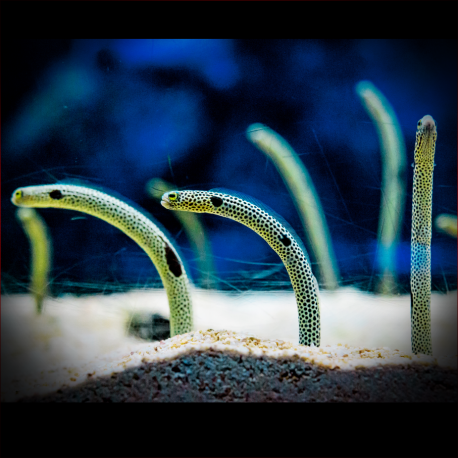More info
Datasheet
| Minimum Tank Size | 200 litres / 52.83 US gallons |
| Maximum Size | 45.0cm / 17.72inches |
| Reef Compatible | Always reef safe |
| Temperament | Peaceful |
| Temperature | 22.2°C / 71.96°F - 25.6°C / 78.08°F |
| Specific Gravity | 1.020-1.025 |
| Carbonate Hardness | 8-12 |
| pH | 8.1-8.4 |
General Description
The Spotted garden eel (Heteroconger hassi) is a peaceful species belonging to the Congridae family. It is primarily found in the Indo-Pacific region, ranging from the Red Sea to the Society Islands and north to the Ryukyu and Ogasawara islands. With a maximum size of 45.0cm, these eels are known for their distinctive black spots along their bodies.
Aquarium Suitability
Considered suitable for special aquarium setups, the Spotted garden eel requires specific conditions to thrive. They are peaceful in temperament and must be kept in groups of at least three individuals. It is crucial to provide a deep sandy substrate of at least 20 cm to replicate their natural habitat. They are known to be jumpers, so a secure lid is necessary for the aquarium.
Demands, Care, and Hardiness
These eels have average hardiness and need a tank size of at least 200 liters. They are best kept in groups of six to ten individuals with each eel requiring a minimum area of 12 by 12 inches. Regular feeding several times a day is essential, especially when they are newly introduced to the tank. Live food such as Artemia is recommended initially, followed by a transition to frozen foods.
Reef Suitability
Spotted garden eels are considered reef-safe, making them compatible with reef aquariums. Their peaceful temperament and unique appearance make them a good addition to a reef setup without posing a threat to corals or other invertebrates.
Aquarium Setup
Setting up an aquarium for Spotted garden eels involves providing a deep sandy substrate resembling their natural habitat. The tank should have a minimum of 20 cm of fine sand. The eels require live food initially, transitioning to frozen foods once they have acclimatized to the tank.
Behaviour
These eels are shy and tend to hide in their burrows, making feeding a challenge initially. However, once they become comfortable, they are known to eat well. It is important to ensure that there are no aggressive tank mates that may intimidate the eels.
Feeding and Diet
In the wild, Spotted garden eels feed on zooplankton from the water column. In captivity, they can be fed small crustaceans like krill and mysis, as well as zooplankton such as Cyclops and pods. Providing a varied diet is essential for their overall health and well-being.
Habitat and Distribution
Spotted garden eels inhabit sandy areas in the Indo-Pacific region, ranging from the Red Sea and East Africa to northwestern Australia and New Caledonia. They are commonly found in groups, known for creating small but deep burrows in the sandy substrate where they reside and feed on zooplankton from the water column.

